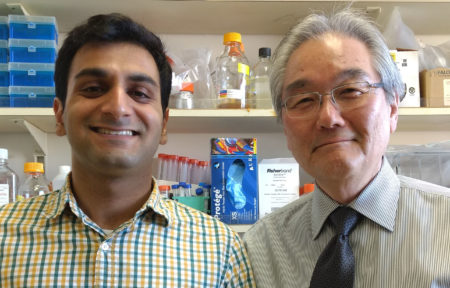Investigators at Washington University have sequenced a murine herpesvirus and determined that it is closely related to HHV-6 & 7. The Murine Rosesolovirus (MRV) causes severe depletion of CD4+ T cells and thymic necrosis in young mice. The authors believe that the newly identified MRV will be a useful mouse model to study the impact of HHV-6 & 7 in humans.

Swapneel Patel, left, and Wayne Yokoyama, Right, of the Division of Rheumatology, Department of Medicine and the Howard Hughes Medical Institute in St. Louis, Missouri.
It is likely that MRV is either the same virus or very similar to murine herpesvirus mouse thymic virus (MTV) because in vivo activity resembles that of MRV. However, since MTV has not been sequenced, this cannot be confirmed. Although it was suggested three decades ago that MTV and HHV-6 might both be members of the same family of “lymphotropic, T cytolytic herpesviruses” (Morse 1999), the Washington University group was the first to explore the connection through sequencing.
The MTV is spread via the saliva and causes severe immunosuppression in neonatal mice, and in some strains, autoimmunity. The immunosuppression is acute for 2-3 weeks but recovers after several months (Cross 1979). MTV can also cause autoimmune disease in some strains of mice (BALB/c and A strain), with 30-40% of infected newborn mice developing autoimmune gastritis and a smaller percentage developing inflammation of the ovaries or thyroglobulin antibodies (Morse 1999). Murine CMV infected mice co-infected with MTV show more severe disease. Adult mice infected with MTV are asymptomatic although they continue to shed virus through the saliva.
MRV/MTV has some striking similarities to HHV-6. Infection of humanized mice with HHV-6A causes severe loss of CD4+ cells in the thymus (Tanner 2013), and when human thymic tissue implanted in SCID-hu Thy/Liv mice was infected with HHV-6A and HHV-6B, the thymocytes were destroyed (Gobbi 1999). Pathogenic effects of HHV-6 in lymphoid tissue were also studied ex vivo, and while HHV-6A depleted both CD4+ and CD8+ cells, HHV-6B only depleted CD4+ T cells (Grivel 2003). HHV-6B and HHV-7 both infect CD4+ T cells, but only HHV-6A infects CD8+ cells (Ablashi 2013). Autoimmunity has also been suggested as a consequence of HHV-6 infection (Caselli 2017, Broccolo 2013).
The complete genome of MRV was sequenced and a phylogenic analysis showed it to be close to the roseoloviruses and more distant to CMV. The authors found the MRV genome to contain almost all of the HHV-6 signature genes including U27, U29, U31, U34-41, U43, U44, U46, U48-50, U53, U56, U57, U64-U67, U70, U72, U74, U76, U77, and U82. Long stretches of the genome mimic the corresponding genomes of HHV-6 & 7. Missing are U48A, U80.5, and U99.
Of 97 MRV ORFs related to known proteins, 65 are similar to HHV-6/7. Included is HHV-6 U54, associated with HHV-6B inhibition of IL-2 and U19, associated with impaired p53 mediated apoptosis. Also identified were homologs for HHV-6 IE1 and IE2, known to dampen type 1 interferon signaling. The MRV genome also possesses unique sequences that distinguish it from HHV-6A/6B/7, especially in the terminal ends.
The Washington University team, led by Swapneel Patel in the laboratory of Dr. Wayne Yokoyama, confirmed that MRV causes thymic necrosis and depletion of T cells in the thymus and spleen of BALB/c neonates. Depletion was found in single and double positive CD4+ thymocytes and both major T cell subsets (CD4+ and CD8+) in the spleen. MRV was found in the spleen, liver, central nervous system, lung, kidney, and salivary gland, but it was found at the highest loads in the thymus, in which T cells mature.
Although roseolovirus homologs have been found in primates (Staheli 2014) and CD46 transgenic mice have been used to study the effects of HHV-6A (Reynaud 2014), the MRV represents the first mouse-specific roseolovirus homolog.
For more information, see the full paper, Patel 2017.

